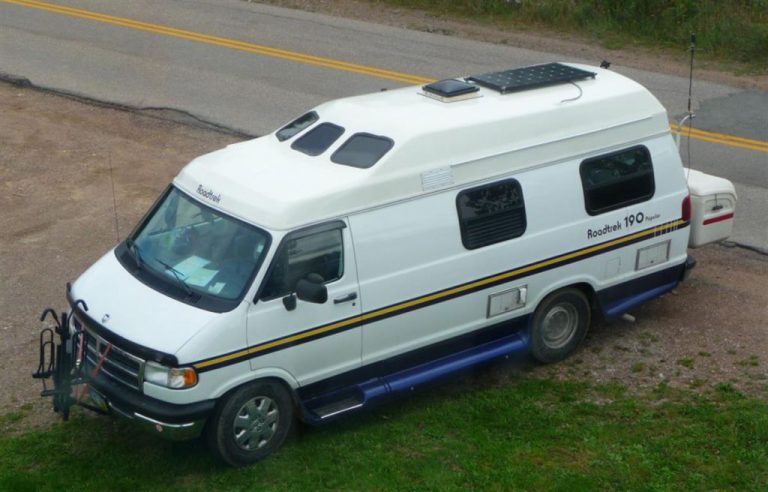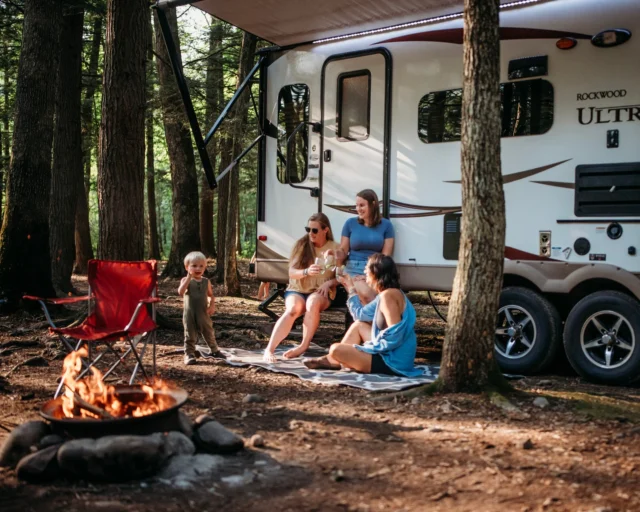
I recently wrote an article on the new Roadtrek CS Adventurous and it’s super cool, lithium battery Boondocking system. The Wendland’s new Class B featured in the article left many of us drooling. (Remember how they actually ran their air conditioning with solar?)
After reading that article many of you wondered if you have to own a new RV to boondock. Well, it seems you weren’t alone. A new article was just posted on Roadtreking.com which discusses this very topic. Here’s a brief look at what the author had to say.
Q: Can a 20-year-old Roadtrek with a single battery successfully boondock?
Yes! The Wendland’s 1995 Roadtrek is a prime example of the Class B boondocking potential. This rig is equipped with an Onan generator and a single group 24 battery with only an 80 amp hour capacity. They also installed a battery monitor which is essential if you plan to stay off-the-grid for more than one night.
The Trimetic battery monitor is a relatively easy install and much better than trying to guess your battery reading. The monitor will tell you how many amps are going in and out of your battery. It will also tell you when your battery is completely powered. This is important because you never want to drain an acid battery below 50%. When you use a battery monitor you can watch what you plug in and how many amps each item uses.
Most Class B RVs have two electrical systems — the 120V and the 12V. The 12V comes from the RV’s battery and needs to be recharged. If you are driving, this naturally happens as you go down the road. The alternator charges the battery via your engine power. The battery can also be charged when it is plugged into a power outlet with a 30 or 50 amp connection. Finally, you can charge your battery with a generator.
If you are planning to boondock or dry camp off grid, you will be using both solar and your generator to keep your battery powered. The key is knowing how many amps each appliance uses while you are still plugged in. Keep a record. Items like lights and music take a lot less amp hours than using a microwave or electric kettle. When you use high amp consuming appliances be sure to turn on your generator and switch your fridge to propane when you aren’t driving.
Another great way to save amps is to change your lights over to LED. Also, look for a 12v TV or DVD players. These uses minimal power and are made for vehicles which makes them a perfect fit. If you use your laptop a lot, either buy a solar charger or use an inverter that allows you to plug your standard cord into a 12V adapter. These are readily available at truck stops or through Amazon ad eBay. Be sure to always charge your electronics when you are on the road. If you have USB based electronics a multi-port charger can be wired into your unit. They use very little energy and are a great alternative to laptops.
Q: How do you stay warm or cool off?
Most Class B furnaces use 3 amps when running, but that will depend on the outside temperature and the insulation. You might consider investing in a 12V heater and warmer bedding. In most cases you can run your low amp furnace for a couple of days without being plugged in.
Air is a little different.With one battery you aren’t going to be running the air conditioning unless you use the generator. A generator can easily provide the battery charge you need to keep cool. If you want to avoid using your generator, try parking in the shade with your awning out. Use window covers to reflect the heat from the sun, and avoid staying in the RV during the hottest part of the day.
Use your rooftop Fantastic Fan along with a few 12V fans and open the windows. If you create a nice breeze your rig should cool down easily. If you open too many windows you can reduce the air flow so you may have to experiment. Monitor your Fantastic Fan and how long you use it. In most cases, these fans use a lots of amp hours if they are on a high setting. Avoid using it continuously by instead using your 12V fans or Sirocco fans to cool your rig once the initial heat has escaped.
Q: How long can you boondock with one battery?
In most cases it will be hard to boondock for more than a couple of days at a time with one battery. If you add even one 100 watt solar panel you will have much more success at keeping your battery charged. If you are careful, with one battery plus a small amount of solar, you can boondock in a Class B for up to a week.
Here’s how Roger and Lynn Brooker, owners of a 20 year old Roadtrek, monitor their battery throughout the day.
The first morning the battery will typically be down to 80-85%. We fire up the Onan to run the Keurig coffee maker and the microwave for breakfast. We also watch the battery monitor to see the amps going into the battery. It starts out around 10 amps, but steadily drops. We typically let it run thorough breakfast and clean up. By then the amps going into the battery are down significantly and we shut it off. Getting batteries above 90% via generator is a long process with a generator. This is where solar panels excel. We will run the generator again for a little while at dinner time. But we will often start the evening at a charge level below the first day.
So what do you think? Would you want to boondock in a Class B? Do you think you could monitor your energy and create a system? Or does it sound like too big of a hassle? Add your thoughts in the comment box below. Your thoughts and suggestions are appreciated. Like this article? Share it with your friends and be sure to read the full article at roadtreking.com.









